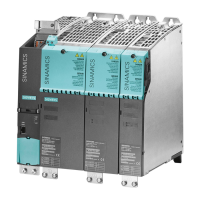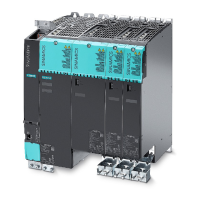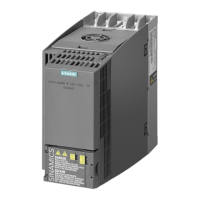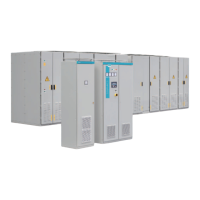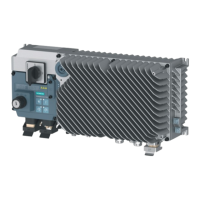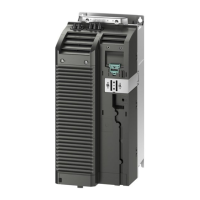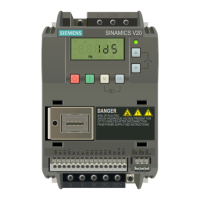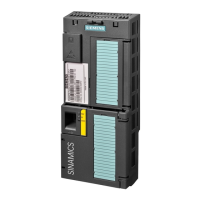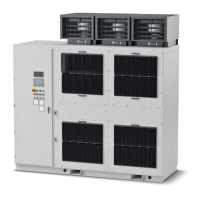Do you have a question about the Siemens SINAMICS S150 and is the answer not in the manual?
Definition of personnel authorized to commission, ground, and label devices.
Device usage restrictions and requirements for correct operation.
Manufacturer's disclaimer regarding publication consistency and liability.
Information regarding the user manual and warning labels.
Contact information for technical support via phone and internet.
General warning about hazardous voltages and safe operation.
Detailed instructions for safe operation and prerequisites.
Precautions for handling ESD-sensitive components.
Overview of SINAMICS S150 applications and key features.
Description of the compact, modular, and service-friendly design of cabinet units.
Explanation of the wiring principle for version A of the cabinet unit.
Explanation of specifications and option short codes on the type plate.
Guidelines for safe transportation, storage, and handling of devices.
General warnings and guidelines for proper installation by qualified personnel.
Checklist to guide through the electrical installation procedure for the cabinet unit.
Crucial safety warnings for high-voltage operation and work on the device.
Guidelines for designing the system to comply with EMC and CE directives.
Instructions for connecting power cables, including cross-sections and lengths.
Details on customer terminal blocks and their interfaces for signal connections.
Information on establishing further connections for installed options.
Introduction to STARTER for configuring and commissioning SINAMICS drives.
Step-by-step guide for commissioning the drive unit using STARTER software.
Overview of the operator panel functions for operation, monitoring, and commissioning.
Initial steps for commissioning the system and selecting language.
Explanation of default settings for command and setpoint sources.
Overview of parameters, parameter types, and parameter categories.
Details on selecting command sources like PROFIdrive, TM31 terminals, NAMUR.
Information on analog inputs, motorized potentiometer, and fixed speed setpoints.
Details on PROFIBUS connection, control, telegrams, and diagnostics.
Overview of operator panel functions, menu structure, and operation modes.
Information on setpoint addition, direction reversal, skip speeds, and speed limitation.
Explanation of V/f characteristic control for induction motors.
Benefits and criteria for vector control with or without an encoder.
Details on analog outputs for setpoints via current or voltage signals.
Information on available bi-directional digital outputs and relay outputs.
Line and DC link identification, harmonics controller, and variable power factor settings.
Motor identification, efficiency optimization, Vdc control, and restart functions.
Technology controller, bypass function, extended monitoring, and position control features.
Procedures for identifying problem causes and rectifying them.
List of faults and alarms with their numbers, causes, and remedies.
Information on service hotlines, online support, and field service options.
Procedures for cleaning, ventilation, and checking cable/screw terminals.
Required tools and tightening torques for current-carrying parts.
Step-by-step instructions for replacing power blocks, fans, and interface boards.
Procedure for reforming DC link capacitors if the device is stored for over 2 years.
Instructions for upgrading firmware for the cabinet unit and DRIVE-CLiQ components.
Electrical, mechanical, and ambient condition specifications.
Detailed specifications for cabinet unit versions, including electrical and mechanical data.
Current and voltage derating as a function of site altitude and ambient temperature.
Definition of personnel authorized to commission, ground, and label devices.
Device usage restrictions and requirements for correct operation.
Manufacturer's disclaimer regarding publication consistency and liability.
Information regarding the user manual and warning labels.
Contact information for technical support via phone and internet.
General warning about hazardous voltages and safe operation.
Detailed instructions for safe operation and prerequisites.
Precautions for handling ESD-sensitive components.
Overview of SINAMICS S150 applications and key features.
Description of the compact, modular, and service-friendly design of cabinet units.
Explanation of the wiring principle for version A of the cabinet unit.
Explanation of specifications and option short codes on the type plate.
Guidelines for safe transportation, storage, and handling of devices.
General warnings and guidelines for proper installation by qualified personnel.
Checklist to guide through the electrical installation procedure for the cabinet unit.
Crucial safety warnings for high-voltage operation and work on the device.
Guidelines for designing the system to comply with EMC and CE directives.
Instructions for connecting power cables, including cross-sections and lengths.
Details on customer terminal blocks and their interfaces for signal connections.
Information on establishing further connections for installed options.
Introduction to STARTER for configuring and commissioning SINAMICS drives.
Step-by-step guide for commissioning the drive unit using STARTER software.
Overview of the operator panel functions for operation, monitoring, and commissioning.
Initial steps for commissioning the system and selecting language.
Explanation of default settings for command and setpoint sources.
Overview of parameters, parameter types, and parameter categories.
Details on selecting command sources like PROFIdrive, TM31 terminals, NAMUR.
Information on analog inputs, motorized potentiometer, and fixed speed setpoints.
Details on PROFIBUS connection, control, telegrams, and diagnostics.
Overview of operator panel functions, menu structure, and operation modes.
Information on setpoint addition, direction reversal, skip speeds, and speed limitation.
Explanation of V/f characteristic control for induction motors.
Benefits and criteria for vector control with or without an encoder.
Details on analog outputs for setpoints via current or voltage signals.
Information on available bi-directional digital outputs and relay outputs.
Line and DC link identification, harmonics controller, and variable power factor settings.
Motor identification, efficiency optimization, Vdc control, and restart functions.
Technology controller, bypass function, extended monitoring, and position control features.
Procedures for identifying problem causes and rectifying them.
List of faults and alarms with their numbers, causes, and remedies.
Information on service hotlines, online support, and field service options.
Procedures for cleaning, ventilation, and checking cable/screw terminals.
Required tools and tightening torques for current-carrying parts.
Step-by-step instructions for replacing power blocks, fans, and interface boards.
Procedure for reforming DC link capacitors if the device is stored for over 2 years.
Instructions for upgrading firmware for the cabinet unit and DRIVE-CLiQ components.
Electrical, mechanical, and ambient condition specifications.
Detailed specifications for cabinet unit versions, including electrical and mechanical data.
Current and voltage derating as a function of site altitude and ambient temperature.
| Voltage Classes | 600 V |
|---|---|
| Control Mode | Vector control |
| Cooling | Liquid cooling, air cooling |
| Communication Interfaces | PROFIBUS, PROFINET, EtherNet/IP |
| Protection | Overcurrent, overvoltage, overtemperature, short circuit |
| Protection Class | IP20 |
